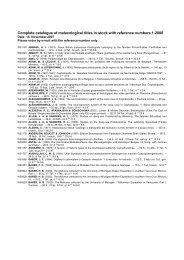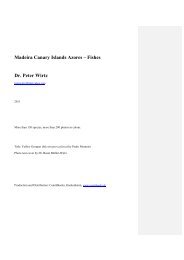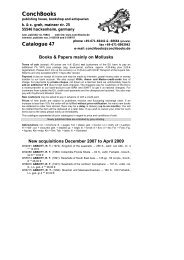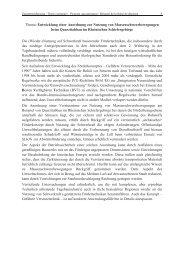Untitled - Conchbooks
Untitled - Conchbooks
Untitled - Conchbooks
You also want an ePaper? Increase the reach of your titles
YUMPU automatically turns print PDFs into web optimized ePapers that Google loves.
Comparing the Nipe-Sagua-Baracoa massif with<br />
the Sierra de los Órganos mountain range, the<br />
former outnumbers the latter in families (26), a<br />
fact that is based on geomorphologic and flora<br />
characteristics.<br />
Both areas have equal number of genera (64);<br />
however, the Sierra de los Órganos exhibits a<br />
larger number of species (230).<br />
Most of the land mollusks in Cuba are located<br />
in the mountains, given that distribution patterns<br />
are based on a combination of factors such as<br />
shade, humidity, shady or sunny slopes, particular<br />
topography, soils and different plant formations,<br />
which lead to the isolation of the populations.<br />
Large geographic areas with a high diversity<br />
of microhabitats, and rugged ground under the<br />
effects of shade and rain provided multiple conditions<br />
in the mountainous areas of Cuba for the<br />
emergence of ecological niches where, inexorably,<br />
events of speciation occurred which favored<br />
the vast diversity of our malacological fauna.<br />
© Adrián González Guillén<br />
� Glyptemoda torrei freirei.<br />
�<br />
Los Negros, Jiguaní, Santiago de Cuba.<br />
En Cuba, la mayoría de las especies de moluscos<br />
terrestres se localizan en las montañas, ya que los<br />
modelos de distribución se deben a la combinación<br />
de factores como sombra, humedad, pendientes<br />
expuestas o sombreadas, suelos y diferentes formaciones<br />
vegetales que provocan el aislamiento de las<br />
poblaciones.<br />
Áreas con una amplia extensión geográfica, alta<br />
diversidad de microhábitats, topografía accidentada<br />
bajo el efecto especial de las condiciones de sombra<br />
y lluvia ofrecieron en las zonas montañosas de Cuba<br />
múltiples condiciones para el surgimiento de nichos<br />
ecológicos donde, inexorablemente, ocurrieron eventos<br />
de especiación que propiciaron la vasta diversidad<br />
de nuestra fauna malacológica.<br />
Liguus fasciatus torrei. South coastal zone of Guanahacabibes.<br />
Liguus fasciatus torrei. Zona costera sur de Guanahacabibes.<br />
�<br />
Veronicella Tenax.<br />
Hoyo de los Helechos, San Carlos, Pinar del Río.<br />
Polymita venusta. Las Calabazas, Holguín.<br />
78 79<br />
© Adrián González Guillén









